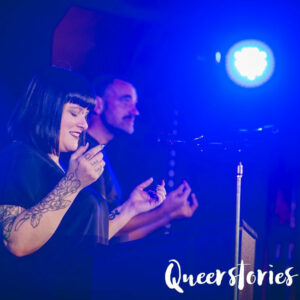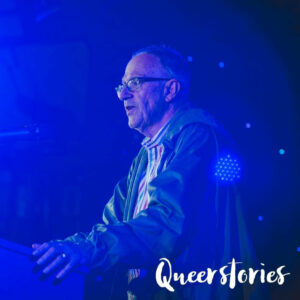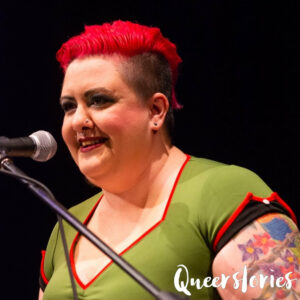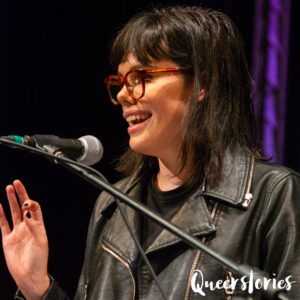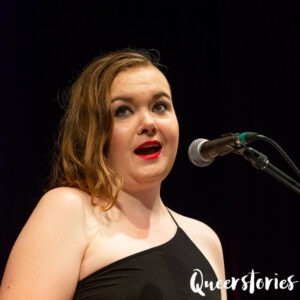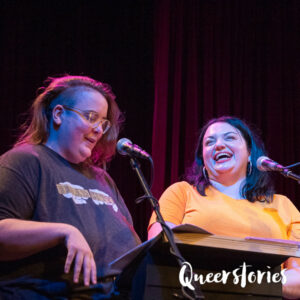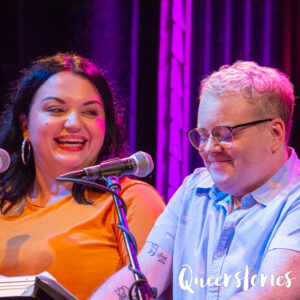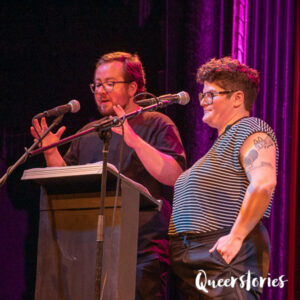Maeve: Hi, I’m Maeve Marsden and you’re listening to Queerstories. This week Travis Larcombe is a local queer writer and proud resident of Tuggeranong. They have been writing funny, sad and inspiring stories since they were old enough to pick up a crayon. Their work has previously been published in SBS Voices, The Chaser, and Perspektif magazine.
Travis: When I moved to Naarm – aka Melbourne – in 2014 I had no idea about my family’s connection to the suburb of Footscray. Up to that point, I’d lived my whole life in sunny, “laid-back” Queensland. Nothing could have been further from the cold winter drizzle and crumbling factory facades of Melbourne’s West. I didn’t even know where Footscray was at first – the geography of Melbourne’s sprawling suburbs with their many tram tracks and 7-11s still eluded me. But I was new in town, and I needed a place to stay. I’d found a cheap room advertised in a queer sharehousing group. The ad said ‘Room for rent in a trans-friendly sharehouse in Footscrazy. You’ll be sharing with Zander, a trans man. Queer friendly, kink friendly, and close to public transport.’
At this time, I had only recently come out as trans. My parents and some of my oldest friends were struggling to digest the changes that were taking place. At the same time I was relearning the most basic aspects of life in my new gender. Like a toddler, everything felt new and exciting, but at other times it was baffling or occasionally just frightening. To top it all off I was made redundant from my job, moved out of the sharehouse I had lived in for two years and I was technically homeless, sleeping in friends spare rooms and lounge room floors. My old life, the structures that had held everything together seemed to simply evaporate and my very soul felt uncomfortably itchy, like a snake before it sheds an old skin. I decided to go back to uni and study communications, to learn to tell stories that could change the world. Why not? What else did I have to lose? Melbourne beckoned with the promise of a fresh start and a strong and vibrant trans community, where I could finally become the man I was supposed to be. So I packed up my things and moved ‘down south’.
I made my way over the Gateway Bridge, accidentally taking every single toll road on the way. From the outside the house was unassuming, but classically Melburnian. It was a small, weatherboard worker’s cottage built in the early 1900s, in a row of similar houses. I’ve always loved old, falling-down houses, the ones that have quirky features and a story to tell.
Though I didn’t know it at the time, my great-great-grandfather on my Mum’s side, Joseph Hunter Goble had also lived in the area. He was a Minister at the local Baptist Church. Joe probably lived in a house very similar to this one, back when Footscray was still a young city. Even back then, Footscray had a bad reputation. It was the site of a large abattoir and a tallow rendering plant which polluted the air and the nearby river, leaving behind a rank odor. The area was mostly inhabited by people who couldn’t afford to live somewhere nicer, such as recent migrants, sailors and dockworkers, homeless people and factory workers. The working-class residents were looked down on by the populace of Melbourne, and they knew it. Footscray became the epicentre of the Victorian union movement. Then in the 1970s and 80s many of the factories closed down taking good union jobs with them. Amid lost hopes and economic decay, drugs came to fill the void. But the people of Footscray, especially the many migrant communities who call the suburb home also possessed a resilience, richness and diversity that was hard to find anywhere else.
When I moved there in 2014, Footscray was ‘up and coming’ – a lovely euphemism for an inner city suburb ripe for gentrification. It was seen as derelict and full of the ‘wrong kind’ of people – new migrants, refugees, the unemployed, queer people, punks, people of colour, poor students, and people who uttered startling screams or talked loudly to themselves on the street or at the train station. People from whom we try to look away. These people became my neighbours and my newly found community. Some of my well-intentioned friends warned me against moving to a ‘bad neighbourhood’. I ignored them. I knew what it was like to be judged based on appearances.
Zander was in many ways a typical Footscrazy queer misfit. A worldly 30-something gemini, his openness and vulnerability taught me much about the transmasc experience. Not long after, we were joined by Mark, a gay man in his mid-20s who quickly became my best friend. It was Mark who taught me how to shave, and who took me to a men’s only gay bar for the first time. Mark introduced me to a gentle kind of masculinity that I hadn’t seen before.
Our house was ancient, and half of it was slowly sinking and gradually splitting in two, like the Titanic. Only the smallest room had an in-built heater. The rest were unheated, a rude shock in Melbourne winter. Despite these shortcomings, living there with my fellow brilliant, quirky misfits Zander and Mark gave me the space to explore myself without fear of judgement. How many people, cis or trans, can say that? How many people ever get to really live freely, authentically and unapologetically as themselves?
Our neighbours were no less quirky. Next door to us was another tumbledown cottage occupied by a lesbian couple who ran a sort of trauma-informed rainbow animal rescue out of their home. Next door to them lived Susan. Susan was our neighbourhood saint, the Good Samaritan of Hocking Street. She’d lived there for 17 years, and she looked out for everyone. Even though she lived on a pension, every Thursday she’d come around with food – dry goods and day old bread from the Foodbank she volunteered with. Susan’s kindness and decency changed many lives, including my own.
I was raised in the Christian faith, but I didn’t like religion. As a kid, the people I saw who claimed to be doing God’s work were mostly people like Fred Nile, George Pell, or the Westboro Baptist Church. So hearing that I had an ancestor who was a prominent member of the Baptist church was an underwhelming discovery. No wonder my family didn’t understand me. Here was more judgement and pain, in the name of an invisible sky-Daddy and his friends Jesus and the Holy Ghost.
But a part of me was also curious. So with Mum’s help I started to do some research. Here’s what we found:
Joseph Hunter Goble was a prominent figure in his day, although by the time I lived there, he was largely unknown. His rousing sermons, tolerance, humility and good humour made him popular with both devout churchgoers and agnostics. At the height of his popularity, over 2000 people would attend his weekly church services, making Footscray the biggest Baptist congregation in Victoria.
Joe was a staunch trade unionist who opposed war of all kinds, and publicly decried jingoism and warlike rhetoric in the lead-up to World War 1. As a young man he was a leader of the printmakers union in Victoria. He didn’t care for religious sectarianism which made him ‘radical’ for the times. He opposed conscription from the pulpit and used his platform to champion the rights of workers. They say that he practiced a personal socialism, lived modestly and could often be seen riding his push bike on his way to visit sick and needy parishioners. Above all he was remembered for his generosity and good deeds.
A man of tall stature – unlike me – he died aged 67. A memorial service held in his honour was attended by thousands. In the Footscray Baptist church there is a picture of Joseph and a stained glass window dedicated to him. It depicts the Good Samaritan.
Suddenly, it all made sense. I wasn’t adopted after all. Someone in my family had actually been super progressive and inclusive for their time. Someone else knew what it felt like to be judged and wanted to make the world a better place for others.
Eventually the fateful day came when we received a note in our sharehouse letterbox – it was a notice of proposed development. All of our houses were to be knocked down, and replaced with brand new, identical townhouses. The stories, the character, the fragile web of relationships that had been built over the years went with them. In that unruly, tumble-down house I found a refuge and a fresh start in life. Even though we’ve all moved on now, I still talk to Mark and Zander now and then. They’re doing well. They said to say hi. We’re part of each others’ stories now, just like Susan, Reverend Joe, the people of Footscray, and you.
Thank you.
Maeve: Thanks for listening. Please subscribe to our podcast, share your favourite tales on socials and follow Queerstories on Facebook for updates. If you enjoy Queerstories, consider supporting the project on Patreon. Check out the link in the episode description. Finally, for late-night ramblings, gay shit and photos of me trying to garden with a baby on my back, follow Maeve Marsden on Twitter and Instagram.












